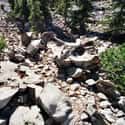-
(#1) Hooded Pitohui Birds Are Toxic To The Touch
Papua New Guinea's hooded pitohui is one of the few poisonous bird species. Their toxicity was discovered by ornithologist Jack Dumbacher in 1989. Dumbacher caught some of the birds in a net; then, as Australian Geographic explains,
As Jack struggled to free the pitohuis from his nets, they scratched his hands and the cuts hurt more than they should have. He put his fingers in his mouth to dull the pain, but that only made his tongue tingle and burn.
After Dumbacher sent the birds' feathers away for study, they were found to contain batrachotoxins. These neurotoxic steroidal alkaloids can be fatal in high doses and are also found in the skin of poison dart frogs. The birds acquire this toxin from feeding on melyrid beetles.
-
(#2) Metal From Sunken WWII Ships Is In High Demand Because It's Uncontaminated By Radiation
If you want to make highly sensitive medical or physics equipment, a cost-effective method is to use the metal from sunken World War II ships. This is because they contain what is known as "low-background steel."
All steel produced after the 1945 atomic bombings at Hiroshima and Nagasaki is contaminated with radionuclides, or radioactive isotopes. Air is required in the steel manufacturing process, and any steel made using atmospheric air has a high chance of containing radioactive particles (a side effect of the more than 1,900 nuclear tests conducted since WWII).
The steel used to make WWII ships was not only produced before atomic testing, but also remains insulated from atmospheric radiation by the ocean depths. In the modern era, it is possible to produce non-radioactive steel in a controlled environment, but this is a more expensive process than simply salvaging the metal from the sea.
-
(#3) China's Three Gorges Dam Is So Massive It Can Slow The Rotation Of The Earth
Though not so much that you'd actually notice. According to Dr. Benjamin Fong Chao, of NASA's Goddard Space Flight Center:
If filled, the [Three Gorges Dam] would hold 40 cubic kilometers (10 trillion gallons) of water. That shift of mass would increase the length of day by only 0.06 microseconds and make the Earth only very slightly more round in the middle and flat on the top. It would shift the pole position by about two centimeters (0.8 inch).
Dr. Chao's comment comes from a 2005 NASA article that explains how many things affect the rotation and shape of the planet, including earthquakes, weather patterns, and even traffic.
-

(#4) The Blast Wave From Tsar Bomba, The Most Powerful Nuclear Device Ever Tested, Circled The Earth Three Times
Tested by the Soviet Union in October 1961, Tsar Bomba created a fireball five miles in diameter and could be seen for 630 miles. As the BBC writes,
Tsar Bomba unleashed almost unbelievable energy – now widely agreed to be in the order of 57 megatons, or 57 million tons of TNT. That is more than 1,500 times that of the Hiroshima and Nagasaki bombs combined, and 10 times more powerful than all the munitions expended during World War Two. Sensors registered the bomb’s blast wave orbiting the Earth not once, not twice, but three times.
The thing was meant to be more of a demonstration of strength than a practical weapon of war. It was 26 feet long, seven feet in diameter, and weighed more than 59,000 pounds.
-
(#5) The World's Oldest Tree Was Cut Down Because A Scientist Couldn't Accurately Measure It
In 1964, graduate student Donald R. Currey was studying the Little Ice Age by measuring the cores of various bristlecone pines in eastern Nevada. While coring one tree, Currey's boring instrument became stuck. So, with the permission of the US Forest Service, Currey had the tree cut down to take samples of it.
Currey, to his everlasting regret, found that the tree was at least 4,862 years old, and possibly older. Later dubbed "Prometheus," this was the oldest, non-clonal tree ever discovered.
However, in 2013, an older bristlecone pine was finally confirmed, at approximately 5,060 years old.
-

(#6) Lysol Was Originally Marketed As A Contraceptive
Contraceptives didn't become legal in the US until 1965, and only then for married couples. Until '65, many advertisements used the term "feminine hygiene" as a euphemism for birth control, according to author Andrea Tone.
In Tone's book on the history of contraceptives, she writes that douching was "the most common form of birth control from 1940 until 1960" - despite being largely ineffective. As Mother Jones reports,
The most popular brand of douche was Lysol - an antiseptic soap whose pre-1953 formula contained cresol, a phenol compound reported in some cases to cause inflammation, burning, and even death. By 1911 doctors had recorded 193 Lysol poisonings and five deaths from uterine irrigation. Despite reports to the contrary, Lysol was aggressively marketed to women as safe and gentle.
When cresol was replaced by ortho-hydroxydiphenyl, Lysol was rebranded as a toilet bowl cleaner and treatment for ringworm, though it was still advertised as a feminine hygiene product.
-

(#7) Approximately 0.001% Of People Who Develop Cancer May Enter Spontaneous Remission - Healing Naturally Without Treatment
The phrase "spontaneous regression of cancer" refers to the process of cancer cells being eradicated by the body's natural immune system. It is an incredibly rare but documented phenomena, occurring in about one in 100,000 cancer patients.
A 2011 article in the Journal of Natural Science, Biology and Medicine notes:
The spontaneous healing of cancer, after having been the subject of many controversies, is now accepted as an indisputable fact. The percentage of spontaneous regression as quoted by Boyers is 1 in 80,000 and 1 in 100,000 by Bashford; it may be subjected to criticism but proves a remarkable fact that cancer is not an irreversible process.
Regression is more commonly associated with groups of tumors like the embryonal tumors in children, carcinoma of the female breast, chorionepithelioma, adenocarcinoma of the kidney, neuroblastoma, malignant melanoma, sarcomas, and carcinoma of the bladder and skin.
-

(#8) Radiotrophic Fungi Are Feeding On Chernobyl's Radiation
Since the 1986 meltdown at the Chernobyl Nuclear Power Plant, a dark fungus has been growing around the area - seemingly nourished by the radioactive soil. The fungus is notable for containing melanin, the same pigment that darkens human skin. Scientific American writes that breeds of fungus that contain melanin are absorbing "high levels of energy in ionizing radiation and somehow turn it into a biologically useful (and benign) form."
One scientific paper reports that "ionizing radiation changes the electron structure of the melanin molecule and that fungi with a natural melanin shell (the soil-dwelling Cladosporium sphaerospermum and yeastlike Wangiella dermatitidis varieties), which were deprived of other nutrients, grew better in the presence of radiation."
More research is required, but the possibilities are exciting. As Scientific American speculates, "melanin-bearing fungi could be used in clothing to shield workers from radiation or even farmed in space as astronaut food."
-
(#9) There Is No 100% Accurate Method For Determining A Person's Age
With the level of advanced medical technology available, you'd think there would be some test to determine how old a person is. However, no scientific method has proven 100% accurate. Tests that look at bone growth, chromosomes, white blood cells, and amino acids can put you in the ballpark - and reveal various aspects of a person's health - but can't nail down the exact age.
The most accurate test, known as the "epigenetic clock," can now get within two to three years of your correct age. Researcher Kang Zhang told Vox this "method likely won't get much more accurate because of the natural variation that exists between people of the same age."
-
(#10) Humans Have The Same Density Of Body Hair As Chimpanzees And Gorillas
Though humans appear to be hairless compared to other great apes like chimpanzees and gorillas, they sport the same number of hair follicles per centimeter of skin.
As National Geographic points out, the hairy divide between humans and other hominids is not measured by volume but type:
We actually have the same density of body hair as other apes of our size, but ours is largely fine and colourless rather than thick and dark. We are coated with a layer of short, fine hair, known technically as vellus hair and colloquially as peach fuzz.
As to why human hair has become finer over time: it may have been to help us detect parasites on our skin; to enable our skin to cool off more efficiently when sweating; or even to boost humans' sexual attraction to each other.
-

(#11) The Scientific Term For Brain Freeze Is 'Sphenopalatine Ganglioneuralgia'
That awful sensation in the front of your head when you eat ice cream too fast? You probably call it "brain freeze" or an "ice cream headache," but its technical term is sphenopalatine ganglioneuralgia. The term refers to a group of nerves located behind the nose that are particularly reactive to pain.
The exact cause of the brain freeze sensation is unknown, but researchers believe it shares a link with migraines. According to Healthline, the current theory about brain freeze goes like this:
when the brain is cooled rapidly as a result of ingesting extremely cold food or liquids, it changes the blood flow in the brain. The cold is transferred from the roof of your mouth to the nerves of the brain, and this causes some kind of reaction in the brain.
-

(#12) Tigers Share 95.6% Of Their DNA With House Cats
In 2013, a team of researchers sequenced the genomes of tigers, snow leopards, and lions. One of the findings was that tigers share 95.6% of their DNA with ordinary house cats. The two species diverged roughly 10.8 million years ago.
New Random Displays Display All By Ranking
About This Tool
Our data comes from Ranker, If you want to participate in the ranking of items displayed on this page, please click here.






